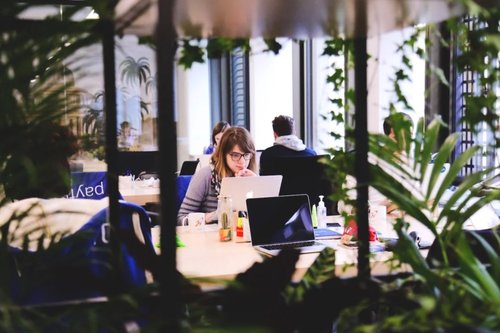Will working from home help save the planet?
Feb 19, 2021
7 mins


Freelance writer & energy regulation analyst
Public life may have come to a standstill but nature has not. In fact, it has thrived. From deer grazing on London lawns to mountain goats invading the Welsh town of Llandudno, wildlife is reclaiming urban areas, free to wander the unusually quiet streets. This is partly due to the drastic changes in the way we work since the start of the Covid-19 crisis that keep so many of us at home all day even outside of lockdowns.
At first glance, it might seem that working from home is better for the environment. After all, commutes are cut out and there’s no heating or lighting in all those vast office spaces. However, the effects of working from home on our carbon footprint are not as clear cut as we might think.
“The impacts of teleworking on emissions are very hard to quantify,” said Steven Sorrell, professor of energy policy at the University of Sussex. Results depend on what we choose to look at—commutes, energy use, indirect emissions, and more—as well as on the geographical and workplace context. Despite these challenges, or perhaps because of them, a large amount of research exists that can help us, at the very least, ask the right questions.
Do fewer commutes mean we drive less?
When it comes to remote work and the environment, commutes are likely to come to mind. Before the pandemic, the majority of us—58% in 2019—traveled to work by car. It makes sense, then, that we’d expect cutting commutes to be an obvious benefit, not only for the time it saves us, but for the environment as well.
In practice, the story is more complicated as we tend to adapt our travel habits to changes in circumstance. “We need to go beyond, ‘Yes you’ve avoided your commute’ and think about other impacts of teleworking on transportation,” said Sorrell. In a review of 39 studies on the energy and climate impacts of remote work, he and his colleagues found that not having to go to the office may lead to unpredictable increases in non-work travel.
This is perhaps less the case now, with our freedom of movement frequently limited by public health restrictions, but worth bearing in mind for long-term remote work practices. “When we are working from home, we rarely work from home all day,” said Sorrell. “There’s some evidence to show that many teleworkers take more non-work trips, and depending on what those are and what mode of transportation you’re using, that’s offsetting the energy savings from the avoided commuter trip.”
Similarly, working from home is encouraging more people to move further away from their workplaces. But Sorrell points out that if this is the case, “when people do go to the office, those trips are longer”. Depending on how often employees are still expected to go to their place of work and their chosen mode of transport, this can again negate some of the potential environmental benefits of fewer commutes.
Do we save more energy at home or at the office?
Even when the carbon footprint is reduced on the transportation front, the International Energy Agency (IEA) stresses that overall work-related emissions may still go up due to increased energy consumption in the home during weekdays. In the UK, residential electricity consumption rose by 15% when the first lockdown began last April.
Does this matter, if our higher energy use at home is counterbalanced by a diminished need for energy in office buildings? Well, it depends. It is generally less efficient to consume energy in numerous single units as opposed to one large space: we tend to use (and lose) less energy overall, say, heating an office for 50 staff than we do heating their 50 homes. This direct comparison, however, leaves out some important variables.
In comparing the average carbon footprint of a person in the UK working from home versus at the office, engineering and professional advisory company WSP found that household composition plays a role. “If there’s two of you working from home, then from a carbon perspective, it is about the same as going to the office,” said David Symons, head of sustainability at WSP. “If there are more than two of you, then it’s better to work from home. But if you’re alone in the house, and you’re heating the whole apartment just for you, it’s generally better to travel to the office.”
Part of this trade-off will depend on insulation, which tends to be better in office buildings than in housing stock. It is also worth making a distinction between full-time and part-time remote work. If working from home is part-time, or temporary, companies are unlikely to downsize office spaces. Heating and lighting needs can in this case remain constant while serving fewer employees. This is why Sorrell believes that “full-time telework has the most potential for energy savings”.
How much paper is in your stationery cupboard?
In offices, printers represent a significant share of energy consumption, both on stand-by and when printing. Add in the paper and cartridges, and it becomes hard to deny that office supplies are a big source of environmental waste in many companies. One printing company found that the average British employee prints about 8,000 A4 pages at work each year. And if all those ink cartridges are not recycled, that ramps up the environmental impact, too.
It is hard to imagine this happening in home offices, not least of all because of the cost, which is rarely reimbursed by employers. Indeed, 30% of UK employees don’t have a printer at home. Those that do have reduced their printing enough to lead 75% of print industry executives in one survey to express concern that the Covid-19 crisis will cause ongoing market disruption.
It remains to be seen whether printing habits will go back to what they were if and when we return to the office. For the time being, however, it seems that when it comes to paper and printing, remote work is rather beneficial for the environment.
Location, location, location
A number of UK-specific assumptions underlie the above points, and the same considerations may not apply everywhere. As Symons points out, the environmental impact of remote work is “different for different regions”.
Seasonal variation is a great example. If you’re in the UK, says Symons, “it is better to work from home in summer, because you don’t have the heating on at home”. In hotter regions, on the other hand, the biggest environmental benefits of remote work are found in winter due to the widespread use of air conditioning in summer.
Regional differences can also tip the balance when it comes to transport. In 2020, 6.6% of new cars sold in the UK were electric. In Norway, by contrast, this figure stands at 54.3%. Needless to say, these market differences have an effect on the environmental consequences of changes to work commutes.
This ties into another important factor: the local electricity mix. Switching from diesel and petrol cars to electric vehicles is one thing, as is the shift from gas to heat pumps for heating, but it also matters where all that electricity is coming from. With the rapid growth of renewable energy sources, the environmental effects of remote work are set to evolve.
Simple changes can go a long way
While it is hard to imagine accounting for all this complexity in the choice of when and where we work—and the environment is, of course, only one of many factors that may influence our preference—some organizations have started thinking about ways to link remote work to their sustainability strategies.
Bartle, a business strategy consulting firm, and BETC, a communications agency, both have flexible work-from-home policies that predate the Covid-19 crisis. But with the changes imposed since the first lockdown, they decided to zoom in on sources of energy use and pollution related to full-time remote work by all employees. Their first point of call was digital technology.
“The energy impact of IT is invisible but enormous”, said Valérie Richard, corporate social responsibility manager at BETC. The company compared data on the energy consumption of the most popular online conferencing tools and the differences in impact between audio and video calls. These insights were used to produce a “green IT guide” for employees, complete with a summary of best practices for “working at home without polluting too much”.
Bartle, a certified B-Corp, conducted a review of the documents stored on the company’s shared online drive and found that 60% of folders were “deletable”, according to Maxime Dupont, who leads the company’s employee-led task force on sustainability practices. As long as these documents were available in one click, a significant amount of energy was being wasted. The content in question has since been deleted, and Bartle has set a limit on the number of versions that employees can store on the cloud for each new document before archiving them. Automatic messages are sent out to users when a folder size surpasses a certain number of gigawatts.
What can you do, starting today?
Keeping our cameras turned off and online storage spaces cleaned up are just a couple of steps we can all take to reduce digital pollution at home. But there’s more we can do while our companies figure out their sustainability policies for the Covid and post-Covid eras.
- Go natural: Make the most of natural light wherever possible to reduce the energy use of artificial lighting. A bonus effect: natural light has also been proven to make us more productive, happier, and healthier.
- Unplug at the end of the day: Leaving electronic devices plugged in is a major but relatively hidden source of electricity consumption. This not only has an impact on the environment, but it also hikes your electricity bill needlessly.
- Hot-desk at home: If you do find yourself still resorting to paper a lot, hot-desking can help: regularly switch up where you sit down to work, and you might find it’s a lot less appealing to deal with large stacks of documents. Of course, print double-sided and keep recycling bins handy for the paper you do use.
- Get busy in the kitchen: The more lunches and coffees you make at home, the less single-use plastic and paper you’ll waste—a change that can be especially significant if you were not one to bring your lunchbox into work in the past.
- Go easy on the heat: the most impactful solution for greening your home office lies in heating: if you can tolerate cold bathroom breaks this spring, heat only the room you work in during the day. Even better, grab an extra jumper!
Photo: Welcome to the Jungle
Follow Welcome to the Jungle on Facebook, LinkedIn, and Instagram, and subscribe to our newsletter to get our latest articles every day!

More inspiration: Working for the planet

The ‘passion tax’ animal welfare workers are expected to pay
Workers in welfare and rescue organizations, zoos, and veterinary say their love for animals is often exploited, leading to burnout and high turnover
Mar 04, 2024

Healthcare industry emissions are a problem, but doctors can help
Medical professionals are working to address the greenhouse gas impact of their industry, from changing clinic practices to...
Feb 05, 2024

Here’s how to make work safer as climate change worsens heat stress
As though climate change didn't pose enough challenges, rising temperatures are also sapping workers' productivity and health
Aug 23, 2023

Sorting the green from the greenwashed: How sustainable is your employer?
A majority of Americans care about corporate sustainability. But how do you know if your company is walking its climate talk?
Mar 27, 2023

The wild dogs of Chernobyl: the story of the pups born on radioactive wasteland
What happened to the animals left behind after the nuclear disaster in Ukraine, and who are the people helping them?
Nov 16, 2022
The newsletter that does the job
Want to keep up with the latest articles? Twice a week you can receive stories, jobs, and tips in your inbox.

Looking for your next job?
Over 200,000 people have found a job with Welcome to the Jungle.
Explore jobs